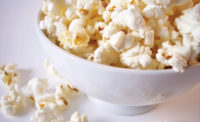If you’ve ever had dim sum at a Chinese restaurant, you may have noticed a few different types of buns available for purchase, either steamed or baked. Generally, these buns will be filled with barbecue pork, but their fillings may surprise you; they could be filled with chicken, beef, or even a sweet filling, like pineapple or custard.
These are known as baozi, or bao for short, and they are more popular than ever—especially in the United States.
A history of tradition
Baozi is generally just known as “bao,” or “cha siu bao” if it contains barbecue pork. If it’s filled with broth or soup, it’s known as “xiao long bao,” which have also been called “soup dumplings.” It originated in China back in the Three Kingdoms time period (220–280 A.D.), and was reportedly invented by Zhuge Liang, a military man who was on a trip to South China. His army caught the plague, and he invented bao—which has a circular shape, like a human head—and stuffed it with pork and beef to offer it as a sacrifice, and later as food, to help cure the plague (ChinaDaily.com.cn).
Originally these bao were called “mantou” (“flour head”), and later they became a staple in Chinese cuisine.
Nowadays, eating bao isn’t quite as serious an endeavor, but bao is becoming more widespread—in the United States, especially, but also in other countries outside China.
From Asia to the States and back
“In Vietnam, they have bao carts punctuating the cityscape on street corners, nestled in storefronts, and they usually have a few stuffed steamed buns at the ready,” says Robert Danhi, chef/partner, Global Flavor Shakers, Los Angeles. “Instead of the sweet and salty barbecue pork that the Chinese have made famous, they tend to chop or grind the pork, mix it with mushrooms, lots of black pepper and garlic, and some fish sauce. The seasoned pork mixtures are placed on the raw dough, then the sausage and egg are placed on top and they are wrapped up and steamed.”
In Malaysia, Danhi adds, bao are also filled with a sweet coconut pandan-scented custard. “In Singapore, I have had black pepper chicken filled bao. Delicious!” he exclaims.
Consumers are now able to purchase bao outside of the traditional Chinese restaurant, too—Trader Joe’s sells frozen Trader Ming’s Cha Siu Bao, and Safeway Select has a similar product. Whole Foods Market has fresh bao in some stores, in its hot prepared foods section, and Wow Bao sells frozen bao, both at its restaurants and in retail.
Charlie Baggs, chairman and executive chef, Charlie Baggs, Inc., Chicago, says that frozen bao has a very high viability. “Bao is a great carrier and very versatile. You will see it used in multiple ethnic cuisines as a ‘mash up,’” he adds.
Large-volume potential
Rheon produces machines—in particular, the Rheon Encrusting Machine—that are able to produce high volumes of bao. “Rheon was founded 53 years ago, and our founder realized that the many different cultures around the world all had some type of filled food product. He set out to invent a machine that could make a filled product, but still maintain a handmade quality,” says John Giacoio, national sales director, Rheon USA, Irvine, CA.
Rheon started in Japan but quickly started selling in many different countries; it now sells in more than 135 countries worldwide.
“In all of these countries, we find the need for a machine that can make filled, handmade-quality food products in many different food categories—we sell in bakery, confection, and the meat industries, to name a few. We have been making bao for almost the entire time our company has been in existence,” adds Giacoio.
The Rheon Encrusting Machine takes an outer casing (in this case, dough) and gently wraps it around the filling. It’s designed to handle particulates up to an inch in diameter. The machine uses a patented shutter system, similar to the shutters on a camera lens; the six shutters come together to cut, seal and wrap the product.
“Since the introduction of the machine, we have added many available options that include encrusting up to three different materials, one inside the other. We can also take a whole piece and place it inside a product. For bao, we have developed a special shutter—instead of a smooth bun top, we can make the traditional twist design on top, for a meat bun that looks handmade. We recently introduced a secondary machine that can place these twist designs on the bao after it has been formed. This machine allows us to fill the bun even more than before. It has the ability to add 9, 12, 18 or 24 folds, to make a beautiful twist design,” says Giacoio.
“The fillings we see are varied, but are typically meat, vegetable, custards, fruit jams, and even bean paste,” Giacoio adds.
Sweet and savory
Besides cha siu bao (barbecue pork-filled) and xiao long bao (soup/broth filled), bao can contain many different flavors, both sweet and savory. Sweet bao tend to contain sweetened adzuki bean paste, lotus seed paste or custard. Savory bao can include pork, beef, seafood or vegetables.
“Bao can be filled with nearly any ingredient—pork is the most common, but you’ll also find chicken, shrimp, vegetables, and even sweet variations,” says Mike Kostyo, senior publications manager, Datassential, Chicago.
Datassential found that some of bao’s top flavors on restaurant menus today include pork (60 percent), chicken (43 percent), shrimp (35 percent), spicy flavors (31 percent) and kung pao flavors (20 percent). Other flavors on the list included pork belly, vegetables, peanuts and peppers.
Operators are also getting creative. “Today’s consumers will find plenty of non-traditional variations of bao, like ‘bao-wiches’ and ‘bao-cos’ (bao tacos). Bao can be an appetizer, a snack, a side, a bar menu option, or a catering choice, and a few of them can be served together as a combo,” continues Kostyo.
The landscape of what was once considered “bar food” is changing for the better. Atwater Brewery in Detroit offers bao as part of its autumn seasonal menu, with a twist.
“Our concept ties into German heritage. We chose one of the elements to be ‘wieners’—largely, these were tasty meats, predominantly pork, with strong-flavored mustard between a roll. When I heard that Atwater Brewery was possibly looking to expand into the international market, I overheard South Korea was on the list. So I went back to my experience working and living in Asia, where lots of bao options are available—it was an easy transition into our concept,” says Adam Hightower, consulting corporate executive chef, Atwater Brewery.
More bao dishes are in the works at Atwater. “Our new bao include a banh mi-ish Vietnamese-style sandwich, with pork belly and fresh Vietnamese veggies. Also in the works is an ‘Oh Wow Bao’ and weekly specials,” says Hightower.
The Safehouse, located in San Diego, CA, has a very bao-centric menu, and its owner grew up eating bao.
“My mom would make bao for my siblings and me, and we would also eat it at dim sum restaurants,” says Nick Thanasith, owner, The Safehouse. “We currently have 15 different baos on the menu. We started off with five—pork belly, duck, fried tofu, soft shell crab, panko shrimp—and kept adding. I was a sushi chef, so there’s definitely an influence in the bao ingredients and garnishes.”
Some adjustments have been necessary. “Some bao flavors didn’t work, so we added and deleted flavors until we found what people like,” continues Thanasith.
For those who are vegetarian, there are other savory options—bao can be filled with tofu, mushrooms or grilled vegetables with aromatic sauces, says Baggs.
“Right now, we see bao customers filling buns with non-traditional fillings, like some of the favorite Chinese-American dishes we order at the local takeout place. The concept is the same: Give the customer an easy-to-hold, easy-to-eat meal in a bun,” says Giacoio.
Trending upward
Bao continues to grow. “In the past year, we moved bao from the first Inception stage of our Menu Adoption Cycle, to the Adoption stage, signaling its growth and acceptance. Part of that growth is due to the rise of ethnic flavors overall, but is also due to bao’s adaptability,” says Kostyo.
“Bao is totally a trend now. A lot of non-Asian restaurants have it on their menus, too—I heard there’s a non-Asian owned place nearby that has bao as their main menu item. A few years ago, that would have never happened,” comments Thanasith.
Bao is very popular among millennials, most likely because of the variety of flavors that it encompasses. “A lot of millennials come in just for the baos. The baos are as popular as our ramen, and some customers order both,” says Thanasith.
“There is great potential for bao as the next slider-type bun,” says Baggs. “The neutral flavor of bao works well with all savory meats from around the world, and there are many options for bao in the future.”















